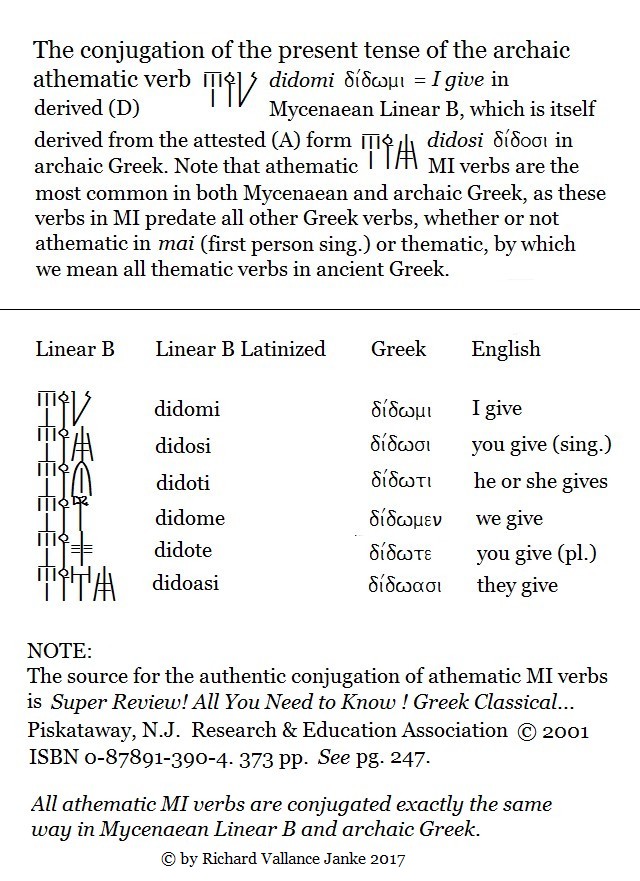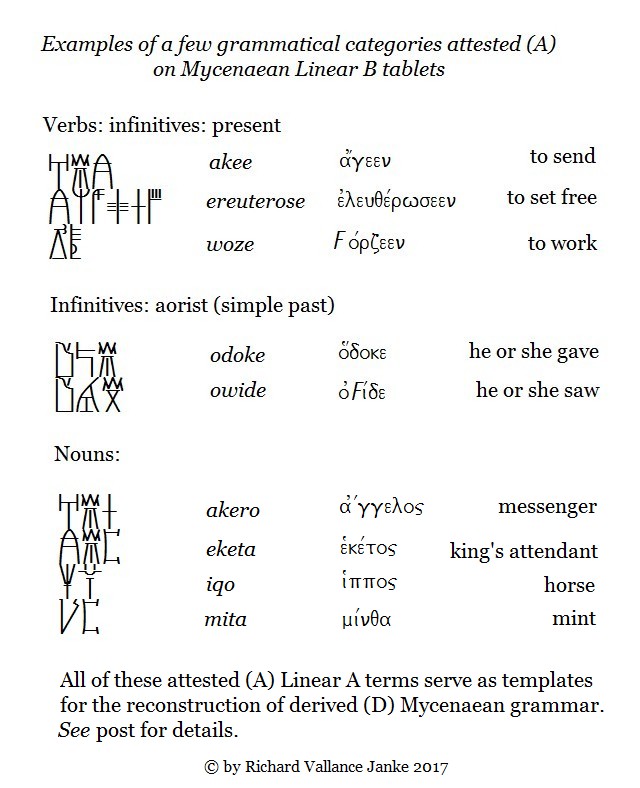CRITICAL POST: What is Mycenaean Linear B progressive grammar & how do we derive it from attested (A) grammatical forms?
We must first extrapolate as many elements of attested (A) grammar from extant Linear B tablets as we possibly can before even thinking of addressing Mycenaean Linear B derived (D) progressive grammar. I shall significantly expand this post in a new article soon to appear on my academia.edu account. Pardon the pun, but keep posted. This article, which is to serve as the formal introduction to derived (D) Mycenaean Linear B grammar, is bound to have a decisive impact on the Linear B research community. If this is not enough, just wait until researchers are confronted with the entire corpus of derived (D) Mycenaean Linear B grammar, which is much larger and more comprehensive than anyone can currently imagine, apart from myself. Since no one to date has ever assayed a relatively complete reconstruct of Mycenaean grammar, THAT will really hit home! The essays on derived (D) Mycenaean Linear B grammar will need to be subdivided by grammatical categories, verbs first, then nouns, etc., to prevent us from overwhelming our readers with the substantial mass of data we shall be covering.
Before we can even pose the question, “What is Mycenaean Linear B derived (D) progressive grammar?”, we must account for any and all traces of Mycenaean grammar on the extant tablets. If we are to rely on the Mycenaean Linear B tablets, regardless of provenance, for signs of Mycenaean grammar, we are bound to be somewhat disappointed. Nevertheless, there remains on the Linear B tablets a corpus of Mycenaean grammar, considerably more substantial than we might have suspected, which is sufficiently viable for the reconstruction from the ground up of significant corpus of Mycenaean derived (D) grammar. In fact, the attributed (A) elements of Mycenaean grammar on extant Linear B tablets provide us with more than enough ammunition to reconstruct a wide spectrum of derived (D) Mycenaean grammar, as we shall soon see. From scanning through Chris Tselentis’ splendid Linear B Lexicon and other extant sources of Mycenaean Greek, I have been able to isolate the following snippets of extant, i.e. attributed (A), Mycenaean grammar. These I have categorized by the discrete grammatical categories with which we are all familiar.
Synopsis:
NOTE that I am resorting to Prof. L.R. Palmer’s convention of LATINIZING all Linear B syllabograms, hence, words and phrases, since listing as many Mycenaean Linear B as I have even for attested (A) grammatical forms is a very tedious process not worth my trouble, let alone anyone else’s. However, I am providing in this post a few examples of actual attested (A) Linear B words, along with the complete derived (D) conjugation of didomi (I give), derived from the attested (A) didosi (they give) below. Here is the conjugation in the present active tense of the athematic verb didomi, fully restored:
 Here you see examples of some of the grammatical forms listed in the attested (A) glossary below:
Here you see examples of some of the grammatical forms listed in the attested (A) glossary below:
 For Prof. L.R. Palmer’s extremely comprehensive glossary of Mycenaean Linear B words, see The Interpretation of Mycenaean Texts (1963), pp 403-466. Apart from Chris Tselentis’ Linear B Lexicon, this is far and away the most useful source of Mycenaean Linear B.
KEY to abbreviations:
ps = person singular; pp = person plural; f = future; o = optative; dat = dative; pi (siffix)= instrumental or primeval ablative case e.g teukepi = with instruments or paraphernalia
Verbs:
Infinitives:
Present:
akee = to send
akere = to gather, collect
apieke – to be covered all over
apudoke = to deliver
ekee = to have, hold
eree = to row
ereuterose = to set free, deliver from
pere = to bring
piriye = to saw
woze = to work
Future passive:
dekasato = to be accepted
Future:
eureuterose = to set free (in the future)
Present indicative active:
ake 3 ps = he or she guides (sends?)
apeeke 3ps = he or she lets go
apieke 3ps = it contains???
apudoke 3ps = he or she delivers
didosi 3pp = they give, devote, grant
dose(i) 3ps = he or she gives
dososi 3pp = they give
ekamate 3ps = he or she stays
eke 3ps = he or she has
eko 2ps = I have
ekome 1pp = we have
ekote 2pp = you have
ekosi 3pp they have
eesi 3ps 3pp = he or she is, there is/they are?
ereutero 1ps = I set free
kitiyesi 3pp = they cultivate
operosi 3pp = they owe
oudidosi 3pp = they do not give, are not giving
pasi 3pp = they say
pere = he or she brings
piriyo = I saw (i.e. a log)
ponike 3ps = he or she decorates with a griffin
teke = he or she puts or sets
toqide 3ps = it has spirals
weke = he or she works
wide = he or she sees
zeukesi 3pp = they yoke or span
Present passive:
ekeyoto = they are included
Present optative:
epikowo 3ps = that he or she may pay attention to
euketo 3ps = that he or she may wish (for)
qiriyato = that he or she may buy
uruto = he or she may guard
Aorist:
didosi = they gave = 3rd. person plural present tense
odoke = he or she gave
oporo = they owed
teke = he or she assigned
owide (wide) = he or she saw
Participles:
Present Active:
apeaso/a 3ps = absent
diuyo/a or diwiyo/a 3ps = belonging
eko/ekontes 3ps/3pp = having
eo 3ps = being
iyote 3pp = coming
kesenewiyo/a = hospitable (a divine epithet)
opero 3ps & operoso/a + operote 3pp = owing
oromeno/a = watching over
ouwoze = not working
temidweta/te = having rims, i.e. with rims
tetukuwoa/tetukuwea2 = well prepared, ready (for distribution on the market)
toqideyo/a + toqideweso/a = with spirals
zesomeno/a = boiling
Present passive:
anono = not rented
audeweso/a = decorated with rosettes?
dedemeno/a = bound
dedomeno/a = (things) being offered
dedukuyo/a = being apprenticed to
epididato/a = distributed
erapameno/a = sown (as of cloth)
ereutero/a = set free
kuparisiyo/ya = made of cypress
pitiro2weso/a = adorned with feathers
zeukesi 3ppdat = yoked, spanned
wozomeno/a = being fashioned/well made
Passive:
tetukuwo/a = well prepared, ready Cf. etoimo/a (D)
Perfect passive:
aetito/a = not used?
akitito/a = untitled?
amoiyeto/a = just delivered
anamoto/a = not assembled
apato/a = not sown?
emito/a = hired, paid
epididato/a = distributed
epizoto/a = bound, tied on top of
iyeto/a = delivered, offered up (religious connotation)
kakodeto/a = bound with copper?
kekaumeno/a = burned, razed to the ground
metakekumeno/a = dismantled?
qeqinomeno/a = made by twisting
Future perfect passive:
ewepesesomena = things to be returned *
pi (siffix)= instrumental or primeval * ablative case:
We refer to the ablative case as primeval, since it had completely disappeared from ancient Greek as early as Homer.
teukepi = with instruments or paraphernalia
seremokarapi = decorated with sirens
In the next post, we shall be addressing the present, future, imperfect, aorist and perfect tenses of thematic verbs in Mycenaean Linear B.
For Prof. L.R. Palmer’s extremely comprehensive glossary of Mycenaean Linear B words, see The Interpretation of Mycenaean Texts (1963), pp 403-466. Apart from Chris Tselentis’ Linear B Lexicon, this is far and away the most useful source of Mycenaean Linear B.
KEY to abbreviations:
ps = person singular; pp = person plural; f = future; o = optative; dat = dative; pi (siffix)= instrumental or primeval ablative case e.g teukepi = with instruments or paraphernalia
Verbs:
Infinitives:
Present:
akee = to send
akere = to gather, collect
apieke – to be covered all over
apudoke = to deliver
ekee = to have, hold
eree = to row
ereuterose = to set free, deliver from
pere = to bring
piriye = to saw
woze = to work
Future passive:
dekasato = to be accepted
Future:
eureuterose = to set free (in the future)
Present indicative active:
ake 3 ps = he or she guides (sends?)
apeeke 3ps = he or she lets go
apieke 3ps = it contains???
apudoke 3ps = he or she delivers
didosi 3pp = they give, devote, grant
dose(i) 3ps = he or she gives
dososi 3pp = they give
ekamate 3ps = he or she stays
eke 3ps = he or she has
eko 2ps = I have
ekome 1pp = we have
ekote 2pp = you have
ekosi 3pp they have
eesi 3ps 3pp = he or she is, there is/they are?
ereutero 1ps = I set free
kitiyesi 3pp = they cultivate
operosi 3pp = they owe
oudidosi 3pp = they do not give, are not giving
pasi 3pp = they say
pere = he or she brings
piriyo = I saw (i.e. a log)
ponike 3ps = he or she decorates with a griffin
teke = he or she puts or sets
toqide 3ps = it has spirals
weke = he or she works
wide = he or she sees
zeukesi 3pp = they yoke or span
Present passive:
ekeyoto = they are included
Present optative:
epikowo 3ps = that he or she may pay attention to
euketo 3ps = that he or she may wish (for)
qiriyato = that he or she may buy
uruto = he or she may guard
Aorist:
didosi = they gave = 3rd. person plural present tense
odoke = he or she gave
oporo = they owed
teke = he or she assigned
owide (wide) = he or she saw
Participles:
Present Active:
apeaso/a 3ps = absent
diuyo/a or diwiyo/a 3ps = belonging
eko/ekontes 3ps/3pp = having
eo 3ps = being
iyote 3pp = coming
kesenewiyo/a = hospitable (a divine epithet)
opero 3ps & operoso/a + operote 3pp = owing
oromeno/a = watching over
ouwoze = not working
temidweta/te = having rims, i.e. with rims
tetukuwoa/tetukuwea2 = well prepared, ready (for distribution on the market)
toqideyo/a + toqideweso/a = with spirals
zesomeno/a = boiling
Present passive:
anono = not rented
audeweso/a = decorated with rosettes?
dedemeno/a = bound
dedomeno/a = (things) being offered
dedukuyo/a = being apprenticed to
epididato/a = distributed
erapameno/a = sown (as of cloth)
ereutero/a = set free
kuparisiyo/ya = made of cypress
pitiro2weso/a = adorned with feathers
zeukesi 3ppdat = yoked, spanned
wozomeno/a = being fashioned/well made
Passive:
tetukuwo/a = well prepared, ready Cf. etoimo/a (D)
Perfect passive:
aetito/a = not used?
akitito/a = untitled?
amoiyeto/a = just delivered
anamoto/a = not assembled
apato/a = not sown?
emito/a = hired, paid
epididato/a = distributed
epizoto/a = bound, tied on top of
iyeto/a = delivered, offered up (religious connotation)
kakodeto/a = bound with copper?
kekaumeno/a = burned, razed to the ground
metakekumeno/a = dismantled?
qeqinomeno/a = made by twisting
Future perfect passive:
ewepesesomena = things to be returned *
pi (siffix)= instrumental or primeval * ablative case:
We refer to the ablative case as primeval, since it had completely disappeared from ancient Greek as early as Homer.
teukepi = with instruments or paraphernalia
seremokarapi = decorated with sirens
In the next post, we shall be addressing the present, future, imperfect, aorist and perfect tenses of thematic verbs in Mycenaean Linear B.






















You must be logged in to post a comment.